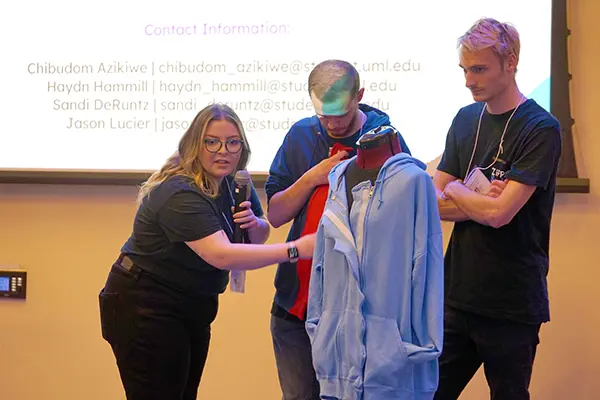Adaptive Clothing Device Takes First Place at Francis College of Engineering Prototyping Competition
 Image by Ed Brennen
Image by Ed Brennen
Zipper Buddy team members, from left, Sandi DeRuntz, Jason Lucier and Haydn Hammill deliver their winning pitch at the recent DifferenceMaker Francis College of Engineering Prototyping Competition at University Crossing. Not pictured is team member Chibudom Azikiwe.
12/13/2023
By Ed Brennen
If you’ve ever tried zippering your coat with one hand, you know it’s an exercise in futility.
But for people with limited use of an arm, it’s an everyday issue that affects the clothes they can wear.
An interdisciplinary team of students — senior liberal arts major Sandi DeRuntz, senior biology major Jason Lucier, junior graphic design major Haydn Hammill and sophomore biomedical engineering major Chibudom Azikiwe — has come up with a way to turn any zip-up garment into one that can be closed one-handed with Velcro.
Their solution, called Zipper Buddy, won the $2,500 first prize at the Rist DifferenceMaker Institute’s recent Francis College of Engineering Prototyping competition, held at University Crossing.
“I’ve never done anything like this in my life, but it’s great to be here and to win,” says Lucier, a Worcester, Massachusetts, native whose team earned a spot in the preliminary round of next spring’s DifferenceMaker $50K Idea Challenge.
 Image by Ed Brennen
Image by Ed Brennen
The crowd reacts after Zipper Buddy, seated foreground, is announced as winner of the DifferenceMaker Engineering Prototyping competition.
Nearly two dozen teams applied to the engineering prototyping competition, with 13 chosen to present their projects to preliminary-round judges in the University Crossing lobby. Of those, five were selected to make five-minute pitches on stage to a panel of judges later in the evening.
Socket Tech, a solution to protect the personal data generated by smart home devices such as Amazon Alexa and Google Nest, took both the second-place prize of $1,500 and the $500 fan favorite award.
Tyler Fanuele, who pitched Socket Tech along with fellow senior computer science major Hayden Dolan, says DifferenceMaker is “one of the most rewarding experiences of my college career.”
“I learned a lot about managing a team and the constraints involved in getting a product ready by a deadline,” says Fanuele, whose team also included Benjamin Romanek, Coleman Nee, James O'Sullivan, Nishanth Potturu, Sarah O'Meara and Devansh Sethia.
Mechanical engineering graduate student Joshua Landis ’22 took third place (and $1,000) with SparkCell, a fast and noninvasive way to test the integrity of concrete bridges and overpasses with a handheld spectrometer.
Landis has been conducting elemental spectroscopy research on concrete — studying the absorption and emission of light and other radiation — for more than a year. When he entered DifferenceMaker and began doing the required market analysis for his pitch, he was “astonished” to learn that bridge inspections are expected to quadruple in the next six years, thanks to President Biden’s $1 trillion infrastructure bill.
 Image by Ed Brennen
Image by Ed Brennen
Mechanical engineering graduate student Joshua Landis '22 pitches his concrete inspection solution, SparkCell.
“It’s certainly going to be good for anybody trying to get into materials testing and infrastructure,” the Billerica, Massachusetts, native says. “I’m really invested in bringing this type of portable, elemental spectroscopy out into the world.”
The winning Zipper Buddy team came together this semester in a new interdisciplinary course called Adaptive Devices for Better Life, which is led by Assoc. Teaching Prof. Yuko Oda (art and design), Assoc. Prof. Erika Lewis (physical therapy and kinesiology) and Asst. Prof. Kelilah Wolkowicz (mechanical engineering).
Students in the course were divided into three teams and matched with a client from the community who needs help performing daily tasks. Zipper Buddy worked with business alum Bob Clancy ’81, who has limited mobility on his left side due to the effects of a stroke. Together, they came up with an attachment made of fabric that zips to an existing garment and closes with Velcro. While the user may need assistance initially zipping the attachment to the garment, it could remain attached indefinitely.
“We didn’t realize there were so many people who needed this device,” says Hammill, who is from Townsend, Massachusetts. “As we started doing research, we realized there’s this gap in the market, so we ran with it.”
 Image by Ed Brennen
Image by Ed Brennen
Engineering Prototyping judge Ram Surdireddy '92, CEO and co-founder of dental insurance management software company Bento, listens to a pitch.
DeRuntz created the first prototype using her child’s sewing machine. The team then connected with Cheryl Gomes, technical program manager of UML’s Fabric Discovery Center, where they developed more advanced prototypes.
DeRuntz, who is minoring in disability studies, has lupus, a chronic autoimmune disease that causes inflammation and pain.
“I started thinking about the winter and how it has been affecting me, and how it would affect Bob,” says DeRuntz, who is from Tyngsboro, Massachusetts. Making a device to help him zip his coat “was a natural thought process,” she says.
“It’s a simple solution to a real problem,” says final-round judge Cynthia Conde '87, '91, CEO of CondeCO.
Conde was joined at the judges table by fellow engineering alumni Chad LaFrance '88, who recently retired as business operations and engineering manager at Texas Instruments; Ram Surdireddy '92, CEO and co-founder of Bento; Greg Sydney '81, senior managing director at Tri Capital & Companies; and Rajia Abdelaziz '16, CEO and co-founder of invisaWear Technologies.
Azikiwe, a DC-CAP Scholar from Washington, D.C., appreciates the interdisciplinary nature of both the Adaptive Devices for Better Life course and the DifferenceMaker program.
“It was a perfect opportunity to take that creative energy and make something beautiful that works for people,” she says.
